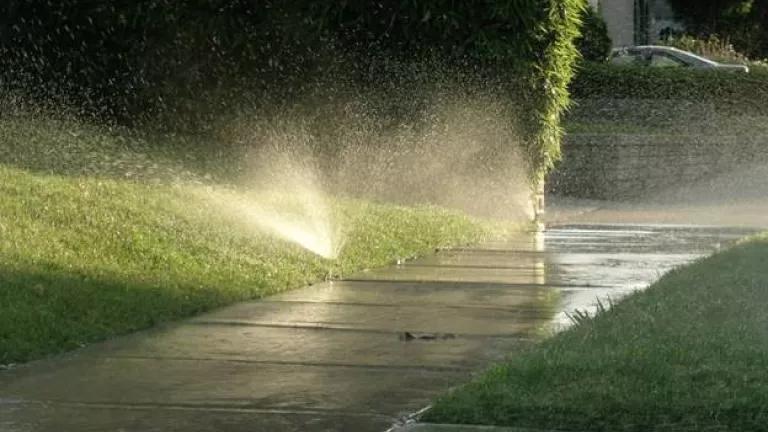New CA Lawn Sprinkler Standards = Huge Water & Energy Savings
California officials have adopted one of the most important and consequential water-saving measures ever implemented by any state, establishing an efficiency standard for new spray sprinklers that will reduce irrigation system misting and overspray that is common around urban landscapes.

Sprinkler Photo by: Adrien Capozzi
California officials today adopted one of the most important and consequential water-saving measures ever implemented by any state, establishing an efficiency standard for new spray sprinklers that will reduce irrigation system misting and overspray that is common around urban landscapes. It’s a huge step given that nearly half of all of California’s drinking water is used outdoors, primarily for landscape irrigation.
The California Energy Commission estimates the water savings will be enormous from this standard—over 400 million gallons per day statewide within 10 years—more than enough to supply all the water used in San Diego, the state’s second-largest city. Water savings this large will save energy as well—an estimated 543 gigawatt-hours of electricity per year by 2030 that won’t be needed to treat and move the water to its destination.
California’s new efficiency standard has been under development for nearly three years, since first being recommended by a state panel on urban water efficiency. During this time, other jurisdictions have been moving forward toward the same goal. The California standard is aligned with the voluntary EPA WaterSense specification for spray sprinklers that was finalized in 2018, and with mandatory standards recently enacted in four other states—Colorado, Washington, Hawaii, and Vermont. However, the water and energy savings from California’s new standard are far larger than for any other state. Nonetheless, with an estimated 40 million to 50 million acres of turf grass across the United States, much of it irrigated, additional states are likely to take note.
What’s Covered by the Rule?
The state standards apply to new spray sprinkler bodies that are purchased or installed in California, beginning next year. A spray sprinkler body is basically the underground housing for a pop-up sprinkler in an automatic landscape irrigation system. Spray sprinklers are the leading type of irrigation for turf grass, and the typical life of a sprinkler body is a bit less than 10 years. The commission estimates that there are over 30 million sold in California every year for installation in new and existing turf areas

How Will New Sprinklers Be Different?
Sprinklers are designed to operate at a specific water pressure to perform as intended. Manufacturers provide the recommended operating pressure for each sprinkler model, most commonly recommending water pressure of 30 pounds per square inch (psi). However, most water utilities serve their customers at pressures well above 30 psi. As I’ve previously written here, NRDC has found that the population-weighted utility average water pressure reported by California’s water utilities is nearly 80 psi—far above levels for optimal sprinkler performance. What’s more, utility water pressure tends to drift upward at night and into the early morning hours, when many automatic sprinkler systems are programmed to run. Operating sprinklers above the water pressure for which they were designed leads to misting and overshooting the target area, both of which waste water.
California’s standard requires new spray sprinkler bodies to come with built-in pressure regulation, so that the water pressure reaching the sprinkler nozzle is always close to the manufacturer’s recommended operating pressure. Compared with standard sprinkler bodies without pressure regulation, the commission estimates that pressure regulated sprinklers will use about 20 percent less water. Pressure-regulating components are expected to add about $3 to the cost of a typical sprinkler body with a 4-inch stem. But the cost is offset by water savings within the first year, making the technology highly cost-effective over the life of the product.
Why Should We Care?
Maybe you live in an apartment, work in a city, and go through the whole day without even seeing anything that looks like a lawn. Why should you care if someone with a big yard saves money on their water bill? The answer is that high irrigation usage during the peak summer season adds costs for utilities that get passed along to all customers. As shown by this graph, water consumption during the summer months can be nearly twice the average winter month, when nearly all usage is indoors.

Reducing peak demand from landscape irrigation can lower costs for everyone and improve the reliability of water service. And like other water efficiency measures, conservation savings are far less expensive than traditional approaches to balancing supply and demand with new water supply projects.
Consider this: By 2030, the state’s new spray sprinkler regulation is estimated to be saving more water each year than the average water supply expected from the proposed $5 billion Sites Reservoir project in Northern California, at far lower cost, and without the environmental impacts of that proposed dam. As my colleague Doug Obegi describes here, NRDC opposes the current formulation of the Sites project, and we are working hard to limit its size and impact, as the current proposal would devastate migrating salmon in the Sacramento River by diverting water in dry and critically dry years and when flows are extremely low.
Reducing landscape water use will become increasingly necessary as communities face greater weather extremes in a warming climate. There are many strategies to consider, from promoting turf replacement and xeriscape to more equitable water rate structures that deliver a stronger price signal for landscape water use. But adopting efficiency standards for landscape equipment, beginning with spray sprinklers, is clearly a policy that other states can implement now to achieve substantial savings over a relatively short period of time. Pressure-regulating technology pays for itself within a year.
California is not the first state to adopt state standards for sprinkler bodies, and it won’t be the last.




